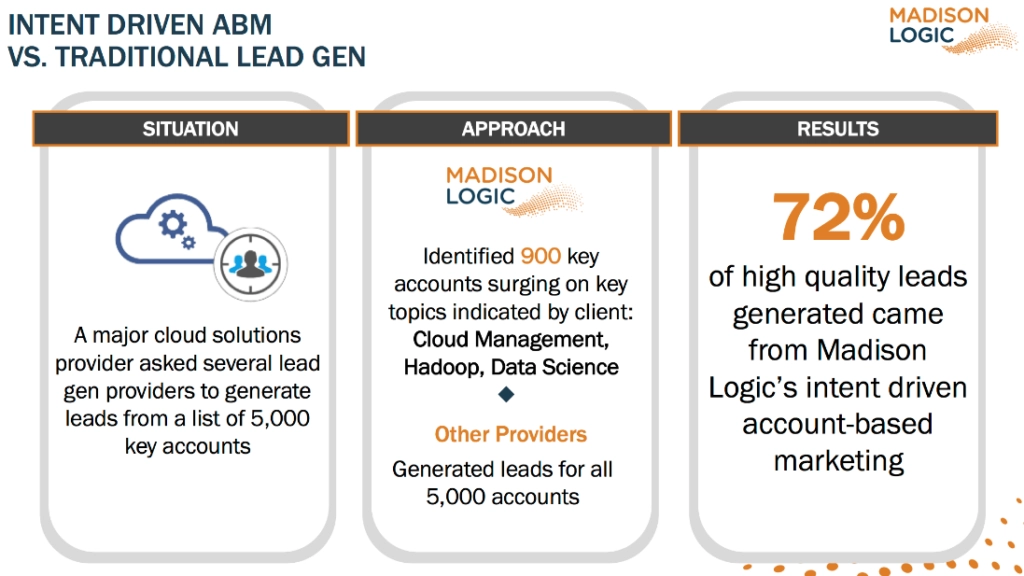
Introduction
Sales and Purchase are traditional market-related concepts that often occur in tandem. However other market-related concepts like production and consumption that are also twined aren’t seen together often. This is due to a lag in one of the factors that determine the logistics value of a product up to the extent that it unavoidably becomes a commodity to consume. An example of such determinants is marketing. Marketing spans across many facets, but our interest in this subject is on accounts based marketing and how purchase intent can improve it.
What is Purchase Intent?
Purchase intent is the business term that refers to a customer’s likelihood to buy your product or seek your service. It is most properly calculated using predictive tools that sit on historical evidence of interest in your commodities. Such tools include population/ demographic studies, revenue, company size, previous purchases, how well a user explores your website and how engaging they might have been with your marketing emails.

Source: Buylike.me
What is Account-Based Marketing?
Account-based marketing, on the other hand, is like custom designing a marketing strategy to fit a particular group of accounts or one specific account.
It thus becomes logical to see that an account-based marketing strategy is incomplete without a source of correct information on the interests and biases of the holders of such accounts. Here is where purchase intent comes in.
Where Account-Based Marketing and Purchase Intent Inflect!
The attributes and needs of a client/Company are not always obvious from the looks of their accounts, therefore it would be somewhere between hard and impossible to predict the intricacies of such client or firm by merely examining the state of their accounts.
However since purchase intent is a statistical study that possesses virtually all the data needed to establish account-based marketing tactics, then it becomes a valuable tool in deciding what variables would be most impactful in upping your Account-Based Marketing campaigns.

Source: Madisonlogic
How Do Purchase Intent Variables Affect My Account-Based Marketing Campaign?
Account-based marketing strategies are not the only subjects that are influenced by purchase intent. Purchase Intent also affects other marketing strategies and may equally dictate what manipulations your messages may need to have the indented impact on customers you send them to.
For account-based marketing, this is what counts.
- Trigger points: this refers to the most impactful factors that are specific to business as they vary. It’s named to mimic the physiological trigger points in delicacy. It most often depends on the field of operation of the business to be marketed, so a good knowledge of the peculiarities of a business should exist if its trigger points are to be detected.
- Key Performance Indicators (KPIs): This is a measure of the performance level of an organization; it could be low-level KPI which is related to the various departments in an organization such as human resources, technical and so on. It could also be a high-level KPI that measures the overall performance of the organization.
- Personal habits: No matter how corporate an organization is, it still is constituted with people, people with interest and biases of their own. This can be leveraged upon to determine the most likely purchase pattern of such organizations.
- Relevance to the level of purchase:There are several steps in the purchase cycle and each of them has different indications to the state of a buyer’s interest. These include the need, specification, order, financial authority, research, choice of supplier and so on. If close attention is paid to these steps, it would be noted that the variations between them are only slight, but, their slightness equates to their delicacies because a strategy that’s designed to manage one stage may backfire if it meets a client at the previous or following stage instead.
The Process
It should be noted that there is no ‘one way fits all’ kind of rule here.
Find the right purchase intent data provider
Are you interested in a third-party intent data or you prefer to scout your client yourself? The possible issue is; sometimes, 3rd party intent data lacks the reliability needed to push forward the selected ABM strategy. However, most times 3rd party intent data are the only available data to stand on, and they end up working well. To make sure this happens you need to ask questions that validate your supplier’s claims.
Questions like; how does your supplier learn their customer’s identities, what purchase intent markers does your supplier consider as relevant? How can they prove the data being purchased is relevant to your products or services and if there’s a guarantee that backs up data quality as an original.
Decide what strategies you’d be most comfortable with
Account-based marketing can be scaled up on three tiers, these are:
- One-to-one ABM (strategic ABM); where all marketing efforts are harnessed toward a single high-value account usually in the league of the seven figures. Here you often will need an executive presentation to further convince your Partner/Client of the need to buy your service.
- One-to-few ABM( scale ABM); here your marketing strategy only targets a category of high-value accounts, your account-based marketing tactic here would be designed like its meant to handle a single account, thus the accounts on this group must have fundamentally similar purchase intent data. A webinar or workshop would do, but if you can do a less generic executive presentation, that would equally be okay.
- One-to-many ABM (pragmatic ABM); this is the most generic of the three, there’s only a little customization necessary here and purchase intent data can vary as logically acceptable.
Finally, it is important to utilize technology to its maximum potential here. The advent of the internet has thrown virtually all fields into a constant state of flux and marketing isn’t left out. So please use the common online tools and be open to new developments as well.
Account-based marketing strategies are maneuverable in a variety of ways, but the most relevant of them, regarding purchase intent, has been described above.
Our blog
Latest blog posts
Tool and strategies modern teams need to help their companies grow.

The 95/5 rule in B2B marketing shows that while only 5% of buyers are ready to purcha...

Running a business comes with its own set of challenges, especially when it comes to ...

AI is surely a futuristic concept but it evolves today, particularly in sales and mar...







